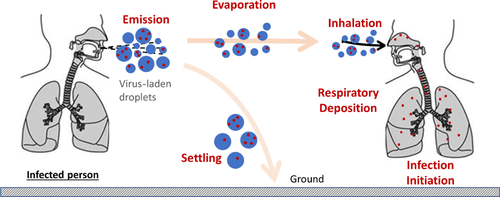当前位置:
X-MOL 学术
›
Environ. Sci. Technol.
›
论文详情
Our official English website, www.x-mol.net, welcomes your feedback! (Note: you will need to create a separate account there.)
Aerosol Dynamics Model for Estimating the Risk from Short-Range Airborne Transmission and Inhalation of Expiratory Droplets of SARS-CoV-2
Environmental Science & Technology ( IF 11.4 ) Pub Date : 2021-06-16 , DOI: 10.1021/acs.est.1c00235 Sukrant Dhawan 1 , Pratim Biswas 1, 2
Environmental Science & Technology ( IF 11.4 ) Pub Date : 2021-06-16 , DOI: 10.1021/acs.est.1c00235 Sukrant Dhawan 1 , Pratim Biswas 1, 2
Affiliation

|
The highly infectious SARS-CoV-2 novel coronavirus has resulted in a global pandemic. More than a hundred million people are already impacted, with infected numbers expected to go up. Coughing, sneezing, and even talking emit respiratory droplets which can carry infectious viruses. It is important to understand how the exhaled particles move through air to an exposed person to better predict the airborne transmission impacts of SARS-CoV-2. There are many studies conducted on the airborne spread of viruses causing diseases such as SARS and measles; however, there are very limited studies that couple the transport characteristics with the aerosol dynamics of the droplets. In this study, a comprehensive model for simultaneous droplet evaporation and transport due to diffusion, convection, and gravitational settling is developed to determine the near spatial and temporal concentration of the viable virus exhaled by the infected individual. The exposure to the viable virus is estimated by calculating the respiratory deposition, and the risk of infection is determined using a dose–response model. The developed model is used to quantify the risk of short-range airborne transmission of SARS-CoV-2 from inhalation of virus-laden droplets when an infected individual is directly in front of the person exposed and the surrounding air is stagnant. The effect of different parameters, such as viral load, infectivity factor, emission sources, physical separation, exposure time, ambient air velocity, dilution, and mask usage, is determined on the risk of exposure.
中文翻译:

用于评估 SARS-CoV-2 短程空气传播和吸入呼出飞沫风险的气溶胶动力学模型
高度传染性的 SARS-CoV-2 新型冠状病毒已导致全球大流行。超过一亿人已经受到影响,预计感染人数还会上升。咳嗽、打喷嚏,甚至说话都会释放出可能携带传染性病毒的呼吸道飞沫。重要的是要了解呼出的颗粒如何通过空气传播到接触者,以更好地预测 SARS-CoV-2 的空气传播影响。对于引起 SARS 和麻疹等疾病的病毒通过空气传播进行了许多研究;然而,将液滴的传输特性与气溶胶动力学结合起来的研究非常有限。在这项研究中,开发了一个由于扩散、对流和重力沉降而引起的同时液滴蒸发和运输的综合模型,以确定受感染个体呼出的活病毒的近空间和时间浓度。通过计算呼吸道沉积来估计活病毒的暴露量,并使用剂量反应模型确定感染风险。开发的模型用于量化当感染者位于暴露者正前方且周围空气停滞时,因吸入载有病毒的飞沫而导致 SARS-CoV-2 短程空气传播的风险。不同参数的影响,如病毒载量、传染性因子、排放源、物理隔离、暴露时间、环境空气流速、稀释度和口罩使用情况,取决于暴露风险。
更新日期:2021-07-06
中文翻译:

用于评估 SARS-CoV-2 短程空气传播和吸入呼出飞沫风险的气溶胶动力学模型
高度传染性的 SARS-CoV-2 新型冠状病毒已导致全球大流行。超过一亿人已经受到影响,预计感染人数还会上升。咳嗽、打喷嚏,甚至说话都会释放出可能携带传染性病毒的呼吸道飞沫。重要的是要了解呼出的颗粒如何通过空气传播到接触者,以更好地预测 SARS-CoV-2 的空气传播影响。对于引起 SARS 和麻疹等疾病的病毒通过空气传播进行了许多研究;然而,将液滴的传输特性与气溶胶动力学结合起来的研究非常有限。在这项研究中,开发了一个由于扩散、对流和重力沉降而引起的同时液滴蒸发和运输的综合模型,以确定受感染个体呼出的活病毒的近空间和时间浓度。通过计算呼吸道沉积来估计活病毒的暴露量,并使用剂量反应模型确定感染风险。开发的模型用于量化当感染者位于暴露者正前方且周围空气停滞时,因吸入载有病毒的飞沫而导致 SARS-CoV-2 短程空气传播的风险。不同参数的影响,如病毒载量、传染性因子、排放源、物理隔离、暴露时间、环境空气流速、稀释度和口罩使用情况,取决于暴露风险。



























 京公网安备 11010802027423号
京公网安备 11010802027423号